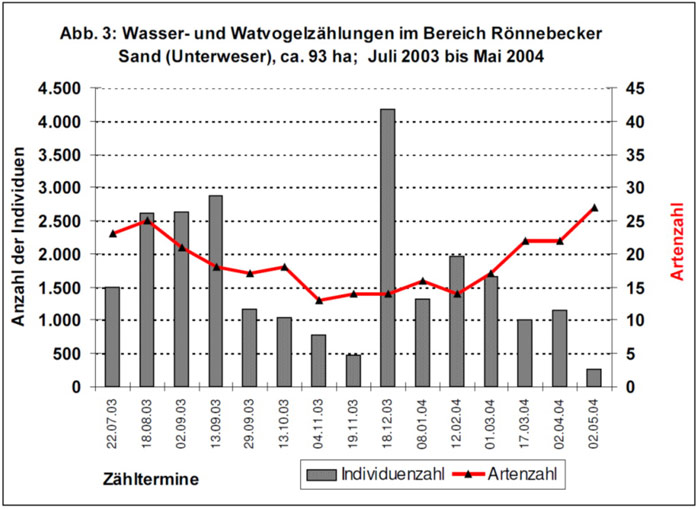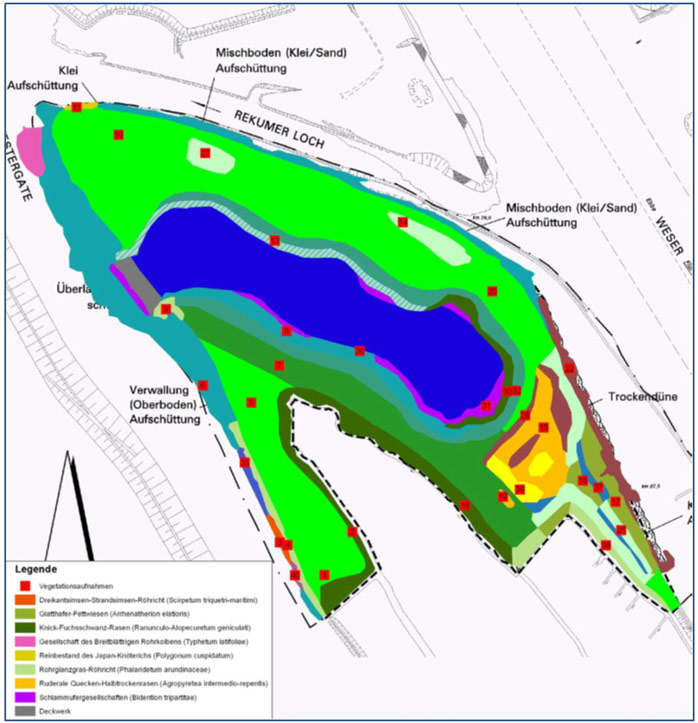

Disclaimer:
The authors are solely responsible for the content of this report. Material included herein does not represent the opinion of the European Community, and the European Community is not responsible for any use that might be made of it.
Back to overview measures
Immediately after measure implementation, several breeding pairs of Pied avocet (Recurvirostra avosetta) used the sandy open bank areas within the project area as breeding grounds. By now, these pioneers have left the area mostly to Lapwing (Vanellus vanellus), Redshank (Tringa totanus) and Little Ringed Plover (Charadrius dubius). On the shallow water zone, numerous water and wading birds were observed. Hundreds of Graylag geese (Anser anser), Common Teals (Anas crecca) and Eurasian Widgeons (Anas penelope) were present.
Mainly due to the occurrence of breeding Corn Buntings (Miliaria calandra), the breeding bird population on Rönnebecker Sand was considered as important for the federal state of Lower Saxony in 2003 after WILMS ET AL. 1997. Since the breeding bird species which founded the area status in 2003 could no longer be observed in 2007, the project area based on more recent counts would have to be considered as of general importance for Lower Saxony. In this context, it has to be mentioned that the method according to WILMS ET AL. 1997 was designed in view of larger spatial units (80-200 ha) and requires multiannual observations in order to prevent coincident effects. Considering the entire 117 ha river island (‘Weserdeicher Sände’) would lead to a designation as important breeding bird site for the federal state of Lower Saxony due to occurrences of Corn Crake (Crex crex) (BIOS 2007A).
According to BIOS 2004, the resting and migrant bird population of the project area can be described as species and individuals rich mostly due to structure diversity and a low degree of disturbances (Figure 3). In particular, the newly created shallow water area provides favorable conditions for most species and individuals during resting and migration time. In addition, the functional connection with other suitable resting grounds has positive effects on the resting bird population of the project area. Therefore, the project area ‘Rönnebecker Sand’ can be considered as integral part of a network of especially suitable resting bird areas in the outer dike area of the Weser River.
Vegetation
The banks of the shallow water zone were settled by reeds and helophytes directly after measure implementation. Especially mass occurrences of Water mudwort (Limnosella aquatica) are worth mentioning (Figure 4, left). The Water mudwort is a raw floor pioneer which is rare in the lower Weser region. To the benefit of pioneer species, the banks of the shallow water zone are grazed by cattle (Figure 4, right). In the longer term, restrictions of cattle grazing are planned and tidal reeds are expected to establish (BIOS 2003).
Inventories of 2007 prove an advanced stage of vegetation development which is no longer exclusively determined by the constructional measures implemented in 2001 and 2002 (Figure 5). A consolidation in terms of a decline of species indicating disturbances and species not belonging to area specific communities can be stated e.g. at the shore of the shallow water zone and on grassland areas. As projected by BIOS 2003, a closed reed belt established at the southern shore of the shallow water zone within four years after cattle grazing was restricted. The northern shore continues to be available for grazing livestock. This guarantees a coexistence of different development stages of shore vegetation (BIOS 2007B).
Benthic invertebrate fauna and fish
Compared to the poor infauna of the lower Weser River, the bed of the shallow water zone is to be considered as species rich. For example, numerous individuals of different Oligochaeta species and Chironomidae larvae occurred (approx. 10 000 individuals of both groups per square meter). Comparable abundances were observed in muddy sections of ‘Westergate’ and ‘Rekumer Loch’ which connect the shallow water zone ‘Rönnebecker Sand’ to the Weser River.
Worth mentioning are occurrences of several endangered aquatic bivalve mollusk species of the family Sphaeriidae (Pisidium henslowanum, Pisidium moitessierianum, Pisidium supinum), but the species richness in the shallow zone is mainly due to undemanding fresh water species widely spread in the lower Weser region and to extreme impoverishment of this component of fauna in the river itself.
The establishment of flowing water species in the mostly stagnant tidal habitat is expected to be possible to a limited extend only. Also more demanding species preferring standing waters or areas with low current velocities were proven to a limited extend within the newly created shallow water zone. For many benthic invertebrate species originally established in the less influenced lower Weser River and its tidal floodplains, nowadays inner dike ditch systems in the lower Weser region serve as substitute habitats.
In 2009, 23 fish species were proven in the newly created shallow water zone and the bordering section of the lower Weser River. Mainly juveniles of Smelt (Osmerus eperlanus), Ide (Leuciscus idus) and Common goby (Pomatoschistus microps) were observed. In the lower Weser River, the number and importance of euryhaline migratory fish species and occasional marine species is significantly higher than in the shallow water zone. Here, only few euraline species –mainly juvenile gobies and flounders (Platichthys flesus)- were of importance. The frequently appearing freshwater species were numerous both in the river and in the shallow water zone. The establishment of a specific fish community of standing water or waters with low current velocities could not be confirmed in 2009. Occurrences of under-water-vegetation as habitat for associated invertebrates and as spawning habitat for different fish species could not be proven. Regarding the shallow water zone, convincing evidences for a significant importance in view of reproduction and overwintering of fish are missing yet (HAESLOOP 2009).
The monitoring program is being continued until 2012.
Back to top
Rönnebecker Sand
Table of content
- 1. Measure description
- 1a. Measure description
- 1b. Monitoring
- 1c. Monitoring results
- 2. Execution of main effectiveness criteria
- 2a. Effectiveness according to development targets of measure
- 2b. Impact on ecosystem services
- 2c. Degree of synergistic effects and conflicts according to uses
- 3. Additional evaluation criteria in view of EU environmental law
- 3a. Degree of synergistic effects and conflicts according to WFD aims
- 3b. Degree of synergistic effects according to Natura 2000 aims
- 4. Crux of the matter
- 5. Literature
Additional information
for this measure:
No further information available.
for this measure:
No further information available.
Monitoring results
BirdsImmediately after measure implementation, several breeding pairs of Pied avocet (Recurvirostra avosetta) used the sandy open bank areas within the project area as breeding grounds. By now, these pioneers have left the area mostly to Lapwing (Vanellus vanellus), Redshank (Tringa totanus) and Little Ringed Plover (Charadrius dubius). On the shallow water zone, numerous water and wading birds were observed. Hundreds of Graylag geese (Anser anser), Common Teals (Anas crecca) and Eurasian Widgeons (Anas penelope) were present.
Mainly due to the occurrence of breeding Corn Buntings (Miliaria calandra), the breeding bird population on Rönnebecker Sand was considered as important for the federal state of Lower Saxony in 2003 after WILMS ET AL. 1997. Since the breeding bird species which founded the area status in 2003 could no longer be observed in 2007, the project area based on more recent counts would have to be considered as of general importance for Lower Saxony. In this context, it has to be mentioned that the method according to WILMS ET AL. 1997 was designed in view of larger spatial units (80-200 ha) and requires multiannual observations in order to prevent coincident effects. Considering the entire 117 ha river island (‘Weserdeicher Sände’) would lead to a designation as important breeding bird site for the federal state of Lower Saxony due to occurrences of Corn Crake (Crex crex) (BIOS 2007A).
According to BIOS 2004, the resting and migrant bird population of the project area can be described as species and individuals rich mostly due to structure diversity and a low degree of disturbances (Figure 3). In particular, the newly created shallow water area provides favorable conditions for most species and individuals during resting and migration time. In addition, the functional connection with other suitable resting grounds has positive effects on the resting bird population of the project area. Therefore, the project area ‘Rönnebecker Sand’ can be considered as integral part of a network of especially suitable resting bird areas in the outer dike area of the Weser River.
Vegetation
The banks of the shallow water zone were settled by reeds and helophytes directly after measure implementation. Especially mass occurrences of Water mudwort (Limnosella aquatica) are worth mentioning (Figure 4, left). The Water mudwort is a raw floor pioneer which is rare in the lower Weser region. To the benefit of pioneer species, the banks of the shallow water zone are grazed by cattle (Figure 4, right). In the longer term, restrictions of cattle grazing are planned and tidal reeds are expected to establish (BIOS 2003).
Inventories of 2007 prove an advanced stage of vegetation development which is no longer exclusively determined by the constructional measures implemented in 2001 and 2002 (Figure 5). A consolidation in terms of a decline of species indicating disturbances and species not belonging to area specific communities can be stated e.g. at the shore of the shallow water zone and on grassland areas. As projected by BIOS 2003, a closed reed belt established at the southern shore of the shallow water zone within four years after cattle grazing was restricted. The northern shore continues to be available for grazing livestock. This guarantees a coexistence of different development stages of shore vegetation (BIOS 2007B).
Benthic invertebrate fauna and fish
Compared to the poor infauna of the lower Weser River, the bed of the shallow water zone is to be considered as species rich. For example, numerous individuals of different Oligochaeta species and Chironomidae larvae occurred (approx. 10 000 individuals of both groups per square meter). Comparable abundances were observed in muddy sections of ‘Westergate’ and ‘Rekumer Loch’ which connect the shallow water zone ‘Rönnebecker Sand’ to the Weser River.
Worth mentioning are occurrences of several endangered aquatic bivalve mollusk species of the family Sphaeriidae (Pisidium henslowanum, Pisidium moitessierianum, Pisidium supinum), but the species richness in the shallow zone is mainly due to undemanding fresh water species widely spread in the lower Weser region and to extreme impoverishment of this component of fauna in the river itself.
The establishment of flowing water species in the mostly stagnant tidal habitat is expected to be possible to a limited extend only. Also more demanding species preferring standing waters or areas with low current velocities were proven to a limited extend within the newly created shallow water zone. For many benthic invertebrate species originally established in the less influenced lower Weser River and its tidal floodplains, nowadays inner dike ditch systems in the lower Weser region serve as substitute habitats.
In 2009, 23 fish species were proven in the newly created shallow water zone and the bordering section of the lower Weser River. Mainly juveniles of Smelt (Osmerus eperlanus), Ide (Leuciscus idus) and Common goby (Pomatoschistus microps) were observed. In the lower Weser River, the number and importance of euryhaline migratory fish species and occasional marine species is significantly higher than in the shallow water zone. Here, only few euraline species –mainly juvenile gobies and flounders (Platichthys flesus)- were of importance. The frequently appearing freshwater species were numerous both in the river and in the shallow water zone. The establishment of a specific fish community of standing water or waters with low current velocities could not be confirmed in 2009. Occurrences of under-water-vegetation as habitat for associated invertebrates and as spawning habitat for different fish species could not be proven. Regarding the shallow water zone, convincing evidences for a significant importance in view of reproduction and overwintering of fish are missing yet (HAESLOOP 2009).
The monitoring program is being continued until 2012.


